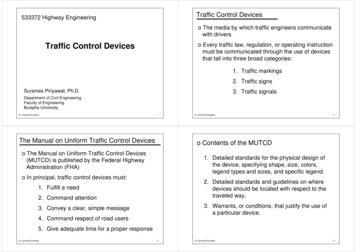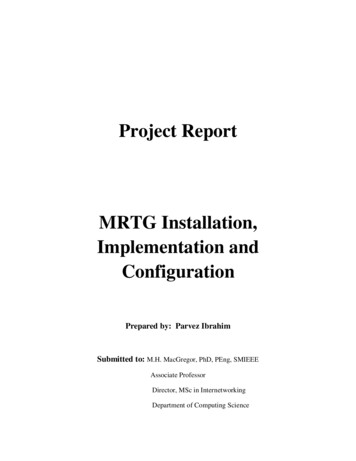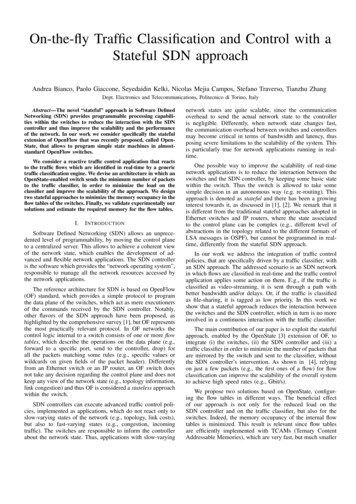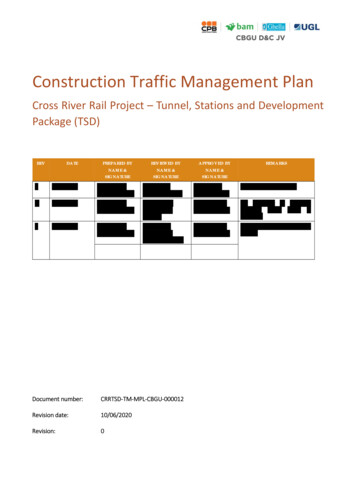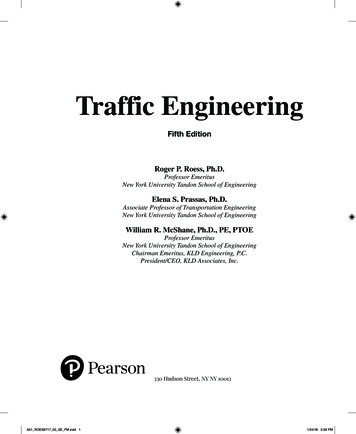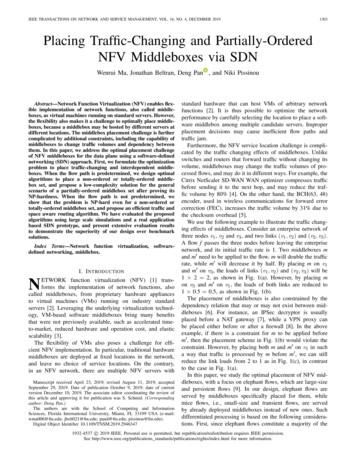
Transcription
IEEE TRANSACTIONS ON NETWORK AND SERVICE MANAGEMENT, VOL. 16, NO. 4, DECEMBER 20191303Placing Traffic-Changing and Partially-OrderedNFV Middleboxes via SDNWenrui Ma, Jonathan Beltran, Deng Pan , and Niki PissinouAbstract—Network Function Virtualization (NFV) enables flexible implementation of network functions, also called middleboxes, as virtual machines running on standard servers. However,the flexibility also makes it a challenge to optimally place middleboxes, because a middlebox may be hosted by different servers atdifferent locations. The middlebox placement challenge is furthercomplicated by additional constraints, including the capability ofmiddleboxes to change traffic volumes and dependency betweenthem. In this paper, we address the optimal placement challengeof NFV middleboxes for the data plane using a software-definednetworking (SDN) approach. First, we formulate the optimizationproblem to place traffic-changing and interdependent middleboxes. When the flow path is predetermined, we design optimalalgorithms to place a non-ordered or totally-ordered middlebox set, and propose a low-complexity solution for the generalscenario of a partially-ordered middlebox set after proving itsNP-hardness. When the flow path is not predetermined, weshow that the problem is NP-hard even for a non-ordered ortotally-ordered middlebox set, and propose an efficient traffic andspace aware routing algorithm. We have evaluated the proposedalgorithms using large scale simulations and a real applicationbased SDN prototype, and present extensive evaluation resultsto demonstrate the superiority of our design over benchmarksolutions.Index Terms—Network function virtualization, softwaredefined networking, middlebox.I. I NTRODUCTIONETWORK function virtualization (NFV) [1] transforms the implementation of network functions, alsocalled middleboxes, from proprietary hardware appliancesto virtual machines (VMs) running on industry standardservers [2]. Leveraging the underlying virtualization technology, VM-based software middleboxes bring many benefitsthat were not previously available, such as accelerated timeto-market, reduced hardware and operation cost, and elasticscalability [3].The flexibility of VMs also poses a challenge for efficient NFV implementation. In particular, traditional hardwaremiddleboxes are deployed at fixed locations in the network,and leave no choice of service locations. On the contrary,in an NFV network, there are multiple NFV servers withNManuscript received April 23, 2019; revised August 11, 2019; acceptedSeptember 29, 2019. Date of publication October 9, 2019; date of currentversion December 10, 2019. The associate editor coordinating the review ofthis article and approving it for publication was S. Schmid. (Correspondingauthor: Deng Pan.)The authors are with the School of Computing and InformationSciences, Florida International University, Miami, FL 33199 USA (e-mail:wma006@fiu.edu; jbelt021@fiu.edu; pand@fiu.edu; pissinou@fiu.edu).Digital Object Identifier 10.1109/TNSM.2019.2946347standard hardware that can host VMs of arbitrary networkfunctions [2]. It is thus possible to optimize the networkperformance by carefully selecting the location to place a software middlebox among multiple candidate servers. Improperplacement decisions may cause inefficient flow paths andtraffic jam.Furthermore, the NFV service location challenge is complicated by the traffic changing effects of middleboxes. Unlikeswitches and routers that forward traffic without changing itsvolume, middleboxes may change the traffic volumes of processed flows, and may do it in different ways. For example, theCitrix NetScaler SD-WAN WAN optimizer compresses trafficbefore sending it to the next hop, and may reduce the traffic volume by 80% [4]. On the other hand, the BCH(63, 48)encoder, used in wireless communications for forward errorcorrection (FEC), increases the traffic volume by 31% due tothe checksum overhead [5].We use the following example to illustrate the traffic changing effects of middleboxes. Consider an enterprise network ofthree nodes v1 , v2 and v3 , and two links (v1 , v2 ) and (v2 , v3 ).A flow f passes the three nodes before leaving the enterprisenetwork, and its initial traffic rate is 1. Two middleboxes mand m need to be applied to the flow. m will double the trafficrate, while m will decrease it by half. By placing m on v1and m on v3 , the loads of links (v1 , v2 ) and (v2 , v3 ) will be1 2 2, as shown in Fig. 1(a). However, by placing mon v3 and m on v1 , the loads of both links are reduced to1 0.5 0.5, as shown in Fig. 1(b).The placement of middleboxes is also constrained by thedependency relation that may or may not exist between middleboxes [6]. For instance, an IPSec decryptor is usuallyplaced before a NAT gateway [7], while a VPN proxy canbe placed either before or after a firewall [8]. In the aboveexample, if there is a constraint for m to be applied beforem , then the placement scheme in Fig. 1(b) would violate theconstraint. However, by placing both m and m on v1 in sucha way that traffic is processed by m before m , we can stillreduce the link loads from 2 to 1 as in Fig. 1(c), in contrastto the case in Fig. 1(a).In this paper, we study the optimal placement of NFV middleboxes, with a focus on elephant flows, which are large-sizeand persistent flows [9]. In our design, elephant flows areserved by middleboxes specifically placed for them, whilemice flows, i.e., small-size and transient flows, are servedby already deployed middleboxes instead of new ones. Suchdifferentiated processing is based on the following considerations. First, since elephant flows constitute a majority of thec 2019 IEEE. Personal use is permitted, but republication/redistribution requires IEEE permission.1932-4537 See http://www.ieee.org/publications standards/publications/rights/index.html for more information.
1304IEEE TRANSACTIONS ON NETWORK AND SERVICE MANAGEMENT, VOL. 16, NO. 4, DECEMBER 20193) For topologies without predetermined paths, we showthat the TAPIM problem is NP-hard even for a nonordered or totally-ordered middlebox set. Our proposedsolution then works in two steps: first finding a path withenough resources to host all the middleboxes, and thenplacing the middleboxes on the given path.4) We have implemented the proposed algorithms in thens-3 simulator and a SDN based prototype, and presentextensive simulation and experiment results to demonstrate the effectiveness of our design.The remaining of this paper is organized as follows.Section II provides a brief overview of related work.Section III formulates the TAPIM problem. Sections IV and Vsolve the TAPIM problem with and without predeterminedflow paths, respectively. Section VI describes the implementation of our prototype. Section VII presents experiment andsimulation results. Finally, Section VIII concludes the paper.II. R ELATED W ORKFig. 1.Traffic changing effects of middleboxes.network traffic [10], optimizing middlebox placement for elephant flows will effectively balance the network load. Second,because mice flows are transient, the yield of their optimizationis marginal. Finally, due to their short duration, utilizing existing middleboxes will help mice flows avoid the instantiationdelay required by new middleboxes. Elephant flows can bestatically determined based on the application types, such asdata backup or VM migration, or dynamically detected usingmany existing techniques in the literature [9], [11]. The processing of mice flows is not in the scope of this paper, andwill be studied in future work.Our solution utilizes the emerging Software-DefinedNetworking (SDN) technology [12] as the implementationplatform, because it enables efficient optimization by decoupling the network control plane and data plane. In the prototype implementation that will be presented in Section VI, wehave developed an SDN controller module to manage the elephant flows: routing the flows and determining their middleboxlocations.Our main contributions in this paper are summarized asfollows.1) We formulate the Traffic Aware Placement ofInterdependent Middleboxes (TAPIM) problem,considering in particular a generalized partial orderfor the middlebox dependency relation, as a graphoptimization problem with the objective to achieve anetwork with balanced link load.2) For topologies with predetermined paths, such as trees,we design optimal algorithms for the special case whenthe middlebox set is a non-ordered or totally-orderedone. For the general case when the dependency relationis a partial order, we show that the TAPIM problem isNP-hard by reduction from the Clique problem, and propose an efficient solution to convert a partially-orderedset to a totally-ordered one.In this section, we briefly review research results in severalrelated categories and highlight our differences.It is challenging to optimize the placement of NFVmiddleboxes, especially with limited available resources.Cohen et al. [13] formulate the NFV location problem, andpropose near optimal approximation algorithms for middleboxresource allocation. Kuo et al. [14] study the joint problemof middlebox placement and path selection by considering thecorrelation between the link and server usages. Sang et al. [15]formulate the middlebox placement problem with the objective to minimize the total number of instances to provide aspecific service, and propose asymptotically optimal greedyalgorithms with constant approximation ratios. Feng et al. [16]propose fast approximation algorithms for the NFV servicedistribution problem. Wang et al. [17] model resource allocation in NFV as a multi-resource load balancing problem,and propose a solution to minimize the maximum dominantload. Ma et al. [18] study the middlebox placement problemby considering the traffic changing effects, with the objectiveto minimize the maximum link load. Fei et al. [19] seek aproactive approach to provision new instances for overloadedvirtual network functions (VNFs) in the cloud. The formalmodel defined in this work differs from the above ones in considering general partial-order dependency relations betweenmiddleboxes. In addition to the formal model, this work alsopresents practical algorithms and a prototype system for designvalidation.A service function chain is a set of network functionsto be performed according to a given order. Multiple models [6], [20]–[25] are proposed to formulate service chainimplementation by solving combined middlebox placementand path computation, mostly using a linear programmingbased approach. Zhang et al. [26] formulate the VNF chainsplacement problem as a bin-packing problem, and proposea priority-driven weighted algorithm. Even et al. [27] propose a randomized approximation algorithm with performanceguarantee. Lukovszki and Schmid propose a deterministicand asymptotically optimal online algorithm for admission
MA et al.: PLACING TRAFFIC-CHANGING AND PARTIALLY-ORDERED NFV MIDDLEBOXES VIA SDNTABLE IL IST OF N OTATIONScontrol of service chains [28], and approximation algorithms based on submodularity for incremental deploymentof middleboxes [29]. Amiri et al. show that general waypoint routing in most practical scenarios, especially withdirected graphs, is computationally intractable [30], andpropose polynomial-time algorithms for graphs of boundedtreewidth [31]. Different from the above works, this workstudies not only the totally-ordered service chain but also nonordered and partially-ordered middlebox sets. In addition tothe dependency relations, this work adds a new dimension byconsidering the traffic changing effects of NFV middleboxes.Due to its capability of global optimization, SDN [32]is commonly adopted as the control protocol to automateand simplify the NFV service provisioning. Multiple architectures [33], [34] are proposed to integrate SDN and NFVfor efficient traffic maneuver. For example, SIMPLE [35] is aSDN-based policy enforcement layer for efficient middleboxspecific traffic steering. StEERING [36] is a scalable framework based on SDN to dynamically route traffic through asequence of services. To support dynamic service chaining,Fayazbakhsh et al. propose an extended SDN architecturecalled FlowTags [37], in which services add packet tags to provide the necessary context for systematic policy enforcement.Our work differs from the above ones by not only implementing the correct policies through SDN, but also considering themiddlebox traffic changing effects and different dependencyrelations.III. P ROBLEM S TATEMENTIn this section, we formulate the Traffic Aware Placementof Interdependent Middleboxes (TAPIM) problem. Table Isummarizes the list of notations for easy reference.Consider a network represented by a directed graph G (V,E). A node v V has a space capacity of sc[v]1 0,i.e., the number of middleboxes that can be hosted. Sinceresource allocation for virtual machines is a well studied problem [38]–[40], we assume for simplicity that eachmiddlebox needs one unit space, and additional processingpower can be achieved by multiple load-balanced middlebox1 We use square brackets [] to denote properties or known values, and roundbrackets () denote to functions or variables.1305instances [41]. A link (u, v ) E has a bandwidth capacitybc[u, v] 0, i.e., the amount of available bandwidth. Theexisting load of the link is denoted as load[u, v].For route calculation, each link (u, v ) E is assigned aweight, denoted as weight(u, v, l), which is a non-decreasingfunction of the link load l, i.e., l l , weight(u, v , l ) weight(u, v , l ). A broad category of weight functions satisfythe non-decreasing requirement, such as the ones used by thepopular Cisco EIGRP [42] and OSPF [43] protocols. The nondecreasing link weight function helps load-balance networktraffic when the routing protocol aims to minimizes the pathcost, which is defined as the weight sum of all the path links.A flow f is defined as a 4-tuple (src, dst, t, M), in whichsrc V is the source node, dst V is the destination node, tis the initial traffic rate when f arrives at the ingress switch ofthe network, and M is the set of required middleboxes. (In casethe flow needs multiple instances of the same middlebox forincreased processing power, M may include multiple copiesof the same middlebox type.)Each middlebox m M has an associated traffic changingratio ratio[m] 0, which is the ratio between the traffic ratesof a flow after and before being processed by m. In reality, thetraffic change ratio may be a constant (e.g., for a BCH encoder)or a variable (e.g., for a WAN optimizer). For convenient andpractical modeling, we use the average in case of a variablein the following formulation.The dependency relation is defined as a strict partialorder on M that is1) Irreflexive: m m,2) Transitive: m m and m m then m m , and3) Asymmetric: m m then m m.Intuitively, m m means that the middlebox m should beapplied before m . (With a slight abuse of notation, whenthere is no confusion, we also use ratio[m] ratio[m ]to concisely describe the traffic changing ratios of m and m and their dependency relation.) For easy representation, definedepend [m, m ] 1 if m m , and 0 otherwise.When the flow f enters the network, a multi-hop path,denoted as route, will be assigned for the flow, which is adecision variable defined as 1, if v V is the i th hop on the path.route(v , i ) 0, otherwise.(1)We define i to start from one, and denote the last hop numberas n for convenience. Repeating nodes are allowed on a pathto enable more general solutions, and hence the path is alsoreferred to as a walk in classic graph theory terms. Due tostate consistency requirements such as in-order packet delivery, splitting traffic among multiple paths is not in the scopeof this paper.In addition, a placement scheme, denoted as place, willdetermine the location for each middlebox m M , whichis a decision variable defined as 1, if m M is placed at the i th hop.place(m, i ) 0, otherwise.(2)
1306IEEE TRANSACTIONS ON NETWORK AND SERVICE MANAGEMENT, VOL. 16, NO. 4, DECEMBER 2019To avoid resource contention between elephant flows andachieve load balance, we do not consider sharing of a middlebox by multiple elephant flows, but instead leave the remainingprocessing capacity of a placed middlebox to mice flows.Use tin (i ) and tout (i ) to denote the incoming and outgoing traffic rate of flow f at the i th hop on the path,respectively. If f is processed by a single middlebox m atthe i th hop, then tout (i ) tin (i )ratio[m]. Note that theincoming traffic rate at the flow source is the initial traffic rate, i.e., tin (1) t. For convenience, use t(u, v ) i [1,n 1] route(u, i )route(v , i 1)tout (i ) to denote thetraffic rate of f on link (u, v).Consistent with most popular routing protocols, such asCisco EIGRP and OSPF, our optimization objective is to determine route and place to minimize the path cost of flow f asshown in Equation (3). It should be noted that the proposedsolutions can easily adapt to other optimization objectives,such as minimizing the maximum link load in the network.minimizen 1 route(u, i )route(v , i 1)i 1 u V v Vweight(u, v , t(u, v ) load [u, v ])(3)subject to the following constraints: i n, v V : route(v , i ) 0(4)route(src, 1) 1, route(dst, n) 1(5) place(m, i )route(v , i ) sc[v ] (6) v V :i [1,n] m M (u, v ) E : t(u, v ) load [u, v ] bc[u, v ] place(m, i ) 1 m M :(7)(8)Fig. 2.Examples of non-ordered, totally-ordered, and partially-orderedmiddlebox sets.once. Equation (9) enforces the dependency relation betweenmiddleboxes, or in other words m must be placed no later thanm if the former is depended on by the latter. Equation (10)states that, the outgoing flow traffic rate at a hop, i.e., tout (i ),is equal to the incoming rate, i.e., tin (i ), multiplying the traffic changing ratios ratio[m] of all the middleboxes m placed atthis hop. It also ensures flow conservation, in the sense that noflow traffic can be generated or terminated at an intermediatenode, except the effects of middleboxes.The above formulation considers only a single flow insteadof multiple flows because of the following practical considerations. First, as will be seen in Sections IV and V, the TAPIMproblem for a single flow is already NP-hard. Therefore, themulti-flow version will be even harder and unlikely to havepractical solutions. Second, for certain applications, it is asmall probability for multiple flows to arrive at the same time.For example, decisions for WAN traffic engineering are takenat large time scales, and can be scheduled for sequential processing. Nevertheless, our algorithms are capable of handlingmultiple flows by updating state variables, such as the serverand link capacity, after each flow arrival and departure, andapplying the algorithms to individual flows.i [1,n] m, m M : place m , i i place(m, i )i i [1,n]IV. M IDDLEBOX P LACEMENT W ITHP REDETERMINED PATHSi [1,n] depend [m, m ] 0 i [1, n] : tout (i ) 1 placef (m, i )(ratio[m] 1) tin (i )(9)(10)m MBrief explanation of the model is as follows. Equation (3)defines the optimization objective. To discourage repeatedlinks on the flow path, when the flow traverses the samelink multiple times, the link weight of each traverse will becounted separately in the path cost. Equation (4) states thatthe n th hop is the last hop of the flow path. Equation (5)enforces the first and last hops of the flow path to be the sourcesrc and destination dst, respectively. Equation (6) states that,for a node v, the total space demand of hosted middleboxesi [1,n]m M place(m, i )route(v , i ) should not exceed itsspace capacity sc[v]. Equation (7) states that, for a link (u, v),the aggregate load of all flows traversing it t(u, v ) load [u, v ]should not exceed its bandwidth capacity bc[u, v]. Equation (8)states that a middlebox m should be installed once and onlyIn this section, we propose solutions for the TAPIM problemwhen the flow path, i.e., route, is predetermined. For example,in trees, there is a unique path between any pair of leaves.We look at three cases of the problem. First, for the specialcase when there is no dependency between any middleboxes,we propose the Non-Ordered Set Placement algorithm thatuses the least-first-greatest-last rule. Next, for the special casewhen there is a total dependency order on the middlebox set,we propose the dynamic programming based Totally-OrderedSet Placement algorithm. Finally, for the general scenario ofa partial dependency order on the middlebox set, we provethat it is NP-hard by reduction from the Clique problem, andpropose an efficient solution to convert a partially-ordered setto a totally-ordered set. Since the flow path is given, for easydescription, we denote the i th hop node on the path as vi .A. Non-Ordered Middlebox SetWe start with the special case that the middlebox set M isa non-ordered set, i.e., m, m M , m m and m m.Thus, different middleboxes can be placed in an arbitraryorder. An example is shown in Fig. 2(a), where no dependency
MA et al.: PLACING TRAFFIC-CHANGING AND PARTIALLY-ORDERED NFV MIDDLEBOXES VIA SDNexists between middleboxes. We propose the Non-Ordered SetPlacement (NOSP) algorithm, and show its optimality.The basic idea is least-first-greatest-last, i.e., to shrink theflow as early as possible by placing the middleboxes thatdecrease the traffic rate from the path head, and expandthe flow as late as possible by placing the middleboxes thatincrease the traffic rate from the path tail.If there are enough spaces on the path, i.e., i [1,n]v V route[v , i ]sc[v ]/i [1,n] route[v , i ] M , the NOSP algorithm places the middleboxes as follows.1) Sort all the middleboxes m M based on their trafficchanging ratios ratio[m].2) Place the middleboxes m with ratio[m] 1 from thepath head in an increasing order of their traffic changingratios. When a node has no more space, continue withthe succeeding node on the path.3) Place the middleboxes m with ratio[m] 1 from thepath end in an decreasing order. When a node has nomore space, continue with the preceding node.4) Check each link (vi , vi 1 ) on the path to ensure no oneis oversubscribed.The pseudo code of NOSP is shown in Algorithm 1. Line 1sorts all the middleboxes m M in the increasing order oftheir traffic changing ratios ratio[m]. Lines 2 to 14 are the firststage to place the middleboxes with traffic changing ratios lessthan one from the head of the flow path. In detail, line 2 initializes by starting with the first hop and the middlebox withthe least traffic changing ratio, i.e., M[1] after sorting. Line 3is the loop to process middleboxes with ratios less than one.Line 4 checks if the current hop vi has available spaces. Ifyes, Line 5 places the middlebox M[j] on vi , decrements thenumber of available spaces sc[vi ] at vi , and increments themiddlebox index j. Lines 7 and 8 check whether the currenthop vi is already the last hop and there are still middleboxeswith ratios less than one to install. If yes, line 9 exits sincethere is no more space on the flow path. Otherwise, if thecurrent hop vi is not the last hop, line 11 continues withthe next hop on the path. Lines 15 to 27 place the middleboxes with ratios greater than or equal to one from thetail of the flow path in a similar manner as above. Lines 28to 32 check each path link to enforce the bandwidth capacityconstraint.The time complexity of NOSP is O(max( M log M , n)),because it sorts the middleboxes with complexity ofO( M log M ), and checks the links with complexity of O(n).Lemma 1: The Non-Ordered Set Placement algorithm minimizes the flow rate on each link of the path.The lemma can be proved by contradiction, and the detailis omitted due to space limitations.Theorem 1: The Non-Ordered Set Placement algorithmachieves the minimum path cost.Proof: By Lemma 1, NOSP minimizes the flow rate oneach path link. Thus, the total load of each link as the sum ofthe existing load and flow rate is also minimized. Given thatthe link weight function weight(u, v, l) is a non-decreasingfunction of the total link load l, NOSP minimizes the weightof each path link and subsequently the path cost.1307Algorithm 1 Non-Ordered Set PlacementRequire: G, f , route, M [1. M ]Ensure: place1: sort m M [1. M ] in non-decreasing order of ratio[m]2: i 1, j 13: while j M and ratio[M [j ]] 1 do4:while sc[vi ] 0 and i n and ratio[M [j ]] 1 do5:place(M [j ], i ) 1; sc[vi ] ; j 6:end while7:if sc[vi ] 0 and j M and ratio[M [j ]] 1 then8:if i n then9:exit with insufficient-space error10:else11:i 12:end if13:end if14: end while15: i n, j M 16: while j 1 and ratio[M [j ]] 1 do17:while sc[vi ] 0 and j 1 and ratio[M [j ]] 1 do18:place(M [j ], i ) 1; sc[vi ] ; j 19:end while20:if sc[vi ] 0 and i 1 and ratio[M [j ]] 1 then21:if i 1 then22:exit with insufficient-space error23:else24:i 25:end if26:end if27: end while28: for i from 1 to n 1 do29:if t(vi , vi 1 ) load [vi , vi 1 ] bc[vi , vi 1 ] then30:exit with insufficient-bandwidth error31:end if32: end forB. Totally-Ordered Middlebox SetNext, we solve the other special case of TAPIM when themiddlebox set is a totally-ordered set, i.e., m, m M , eitherm m or m m, or in other words the middleboxesform a dependency chain. An example is shown in Fig. 2(b),in which m must be placed before m and m before m .Although the placement order of the middleboxes is known, itis still necessary to determine the optimal placement locationfor each middlebox, because there may be an excessive number of available spaces on the flow path. For easy description,we use mj to denote the j th middlebox from the head of thedependency chain, and vi to denote the i th hop node on theflow path, where i and j start from 1.We propose a dynamic programming based algorithm calledTotally-Ordered Set Placement (TOSP) based on the followingobservation. Use TOSP(i, j) to denote the minimum weightsum of the first i links when place the first j middleboxes,i.e., m1 to mj , on the first i hops, i.e., v1 to vi , of the flowpath. The optimal substructure gives the following recursive
1308IEEE TRANSACTIONS ON NETWORK AND SERVICE MANAGEMENT, VOL. 16, NO. 4, DECEMBER 2019formula. w (1; 1, j ), if i 1.TOSP(i, j ) minx [1,j 1] (TOSP(i 1, x 1) w (i; x , j )), otherwise.(11)where w(i; x, j) is the weight of link (vi , vi 1 ) when placingmiddleboxes mx to mj on node vi , i.e.,w (i; x , j ) weightv,v,tratio[m] load[v,v]y ii 1ii 1y [1,j] if sc[vi ] j x 1 and i n. (12) 0, if sc[vi ] j x 1 and i n. 0,ifx j. , otherwise.Equation (11) states that if i 1, TOSP(i, j) is simplythe weight of the first path link when placing all the first jmiddleboxes on the first hop v1 . Otherwise, the optimal resultTOSP(i, j) to place the first j middleboxes on the first i hops isto select the minimum link weight sum among j 1 possiblesolutions, in which the x th solution places the first x 1middleboxes on the first i 1 hops, i.e., TOSP(i 1, x 1),and places the remaining middleboxes mx to mj on the i thhop vi , i.e., w(i; x, j).Equation (12) calculates the weight of the i th path link,i.e., (vi , vi 1 ), when placing middleboxes mx to mj at thei th hop vi , and sets it to zero if x j or infinity if vihas fewer than j x 1 available spaces. A special caseis when vi is the last hop in question, or in other words(vi , vi 1 ) does not exist or is not of interest. Then, the weightis zero if vi has sufficient spaces or infinity otherwise. Notethat if x j and vi has sufficient spaces, w(i; x, j) doesnot depend on x. Specifically, as long as vi has no less thanj x 1 spaces to host middleboxes mx to mj , the weightof link (vi , vi 1 ) is the same, which simplifies the calculation of TOSP(i, j) as the sum of the minimumsub-solution minx [j sc[vi ] 1,j 1] TOSP(i 1, x 1) and a constant.Thus, we can rewrite the recursive relationship as:TOSP(i, j ) minx [1,j 1]{TOSP(i 1, x 1) w (i; x , j )}min{TOSP(i 1, x 1) w (i; x , j )}min {TOSP(i 1, x 1)}x [j sc[vi ] 1,j 1]x [j sc[vi ] 1,j 1] weight vi , vi 1 , load [vi , vi 1 ] tratio[my ] y [1,j ](13)The pseudo code of TOSP is shown in Algorithm 2. Lines 1to 7 conduct the initialization by solving the sub-problems withonly the first hop v1 . In detail, line 1 checks if v1 has j spaces.If yes, TOSP(1,j) is assigned the weight of the first link inline 3, and otherwise infinity in line 4. Lines 8 and 9 start theiteration to recursively calculate the remaining sub-problems.Based on the previous results, lines 10 to 15 finds among theviable schemes the one with the minimum link weight sumAlgorithm 2 Totally-Ordered Set PlacementRequire: G, f , route, M [1. M ], dependEnsure: place1: for j 1 to M do2:if sc[v1 ] j then j3:TOSP(1, j ) weight(v1 , v2 , t y 1 ratio[my ] load [v1 , v2 ])4:else5:TOSP(1, j ) 6:end if7: end for8: for i 2 to n do9:for j 1 to M do10:min 11:for x j sc[vi ] 1 to j 1 do12:if TOSP(i 1, x 1) min then13:min TOSP(i 1, x 1)14:end if15:end for16:TOSP(i , j ) min weight(vi , vi 1 , t jy 1 ratio[my ] load [vi , vi 1 ])17:end for18: end forTABLE IITOSP E XAMPLEto place a portion of middleboxes in the first i 1 hops.Finally, line 16 calculates the optimal TOSP(i, j) by addingthe minimum link weight sum of the first i 1 hops and thelink weight of the last hop.Table II shows an example to apply TOSP to a flow f inthe network of Fig. 1. The detail of the flow is as follows:src v1 , dst v3 , t 1, and M is a total order chain 0.5 2 (the concise notation for two middleboxes m1 and m2 withratio[m1 ] 0.5, ratio[m2 ] 2, and m1 m2 ). Assume thatthe space capacity of
platform, because it enables efficient optimization by decou-pling the network control plane and data plane. In the proto-type implementation that will be presented in Section VI, we have developed an SDN controller module to manage the ele-phant flows: routing the flows and determining their middlebox locations.
